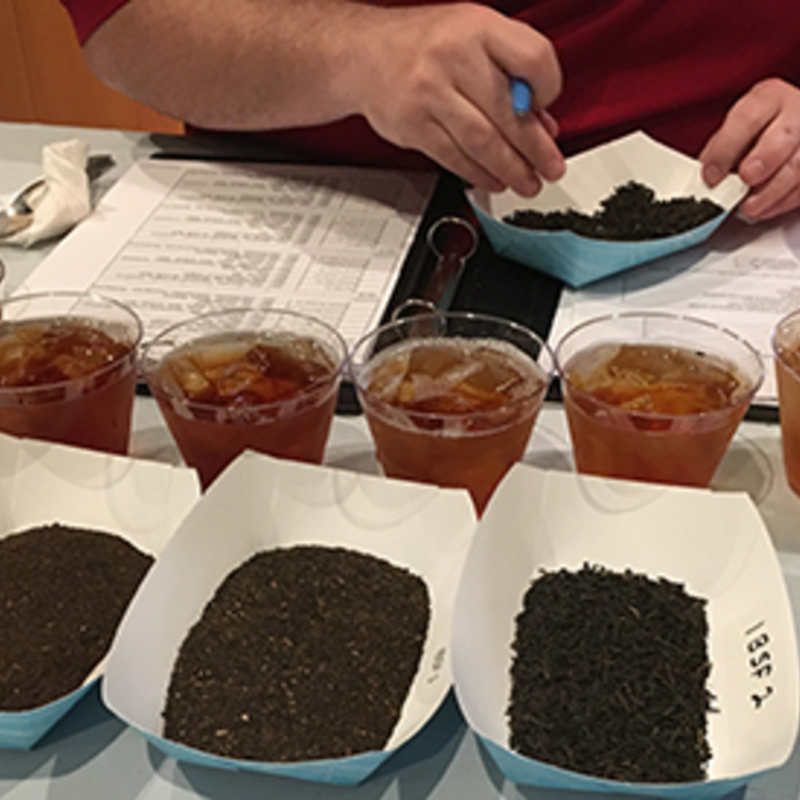Tea Competition
Dublin Core
Title
Tea Competition
Subject
Chinese Tea Culture
The art of tea
Tea competition
The art of tea
Tea competition
Description
Tea-competition represents a higher level of tea-tasting. It originated in the Tang Dynasty and came into fashion during the Song Dynasty. Tea-competition was popular among men of letters in the Song Dynasty. Even Emperor Song Huizeng was enthusiastic about them, and the competitions swept through the imperial palace.
The competitors attached great importance to the instruments and materials to be used, as well as the way the competition was to be conducted. Apart from high-quality tea leaves, there were very strict demands on the condition of the tea water. Tanghua (the foaming surface of tea water) was supposed to be fresh, and white, and as fine and even millet grains: If Tanghua disappeared quickly, and thus revealed a trace of water, the competitor was considered a loser.
To win or lose depended on the competitor's manipulation, which invovled two main skills know as "Dian" and "Fu." "Dian" meant pouring boiling water from the tea pot into the tea cup, hence the term "Dian cha" (pouring boiling water over tea leaves). Pouring was performed in such a way that the water flowed down the inner wall of the cup without disturbing the tea leaves. Water was to spurt from the pot in a column, ending as soon as the pouring was finished. "Dian" was not to be performed with drops of water to be the right amount.
"Fu" meant churning the water with a tiny broom-like tool according to a specified procedure in order to create Tanghua. That is why tea competitions were also known as "Ji Fu."
In the present-day process of "Dian" and "Fu," one holds the pot in one hand and the broom-like tool in the other. The two actions are performed with the latter coming slightly later. At each competition, “Dian” and “Fu” are generally done seven ümes. During the sixth time, the water must be examined to see if it is exactly six-tenths of the cup’s volume and how strong it is. Provided both are desirable, no more “Dian” is necessary. If not, one more attempt will have to be made.
The swift spinning of the tool generates a centrifugal force. This force sets the Tanghua serging and billowing like milk-colored mist. The Tanghua around the inner wall of the cup sticks flrmly to it and is called “Yao Zhan” (biting the cup). Tanghua can remain in this state for a while without vanishing and revealing a trace of water. This is considered the highest degree of success in tea-competiüon.
As its name indicates, tea-competition emphasizes competition. When one achieves the desired result, he is filled with a sense of triumph. Tea-competition is carried out in an atmosphere of intense excitement. Even one who prefers drinking in solitude can derive pleasure from it. Consequently, such competition can exert greater spiritual satisfaction for people than other methods of tea drinking.
The competitors attached great importance to the instruments and materials to be used, as well as the way the competition was to be conducted. Apart from high-quality tea leaves, there were very strict demands on the condition of the tea water. Tanghua (the foaming surface of tea water) was supposed to be fresh, and white, and as fine and even millet grains: If Tanghua disappeared quickly, and thus revealed a trace of water, the competitor was considered a loser.
To win or lose depended on the competitor's manipulation, which invovled two main skills know as "Dian" and "Fu." "Dian" meant pouring boiling water from the tea pot into the tea cup, hence the term "Dian cha" (pouring boiling water over tea leaves). Pouring was performed in such a way that the water flowed down the inner wall of the cup without disturbing the tea leaves. Water was to spurt from the pot in a column, ending as soon as the pouring was finished. "Dian" was not to be performed with drops of water to be the right amount.
"Fu" meant churning the water with a tiny broom-like tool according to a specified procedure in order to create Tanghua. That is why tea competitions were also known as "Ji Fu."
In the present-day process of "Dian" and "Fu," one holds the pot in one hand and the broom-like tool in the other. The two actions are performed with the latter coming slightly later. At each competition, “Dian” and “Fu” are generally done seven ümes. During the sixth time, the water must be examined to see if it is exactly six-tenths of the cup’s volume and how strong it is. Provided both are desirable, no more “Dian” is necessary. If not, one more attempt will have to be made.
The swift spinning of the tool generates a centrifugal force. This force sets the Tanghua serging and billowing like milk-colored mist. The Tanghua around the inner wall of the cup sticks flrmly to it and is called “Yao Zhan” (biting the cup). Tanghua can remain in this state for a while without vanishing and revealing a trace of water. This is considered the highest degree of success in tea-competiüon.
As its name indicates, tea-competition emphasizes competition. When one achieves the desired result, he is filled with a sense of triumph. Tea-competition is carried out in an atmosphere of intense excitement. Even one who prefers drinking in solitude can derive pleasure from it. Consequently, such competition can exert greater spiritual satisfaction for people than other methods of tea drinking.
Type
Art
Coverage
Public
References
Xiousong, L. (1993). Chinese tea culture. The Journal of Popular Culture, 27(2), 75-90.
Embed
Copy the code below into your web page
Item Relations
This item has no relations.
IIIF Manifest
- Date Added
- December 2, 2018
- Collection
- Chinese Tea Culture
- Citation
- “Tea Competition,” CCCH9051 Group 44, accessed July 12, 2025, https://learning.hku.hk/ccch9051/group-44/items/show/28.
